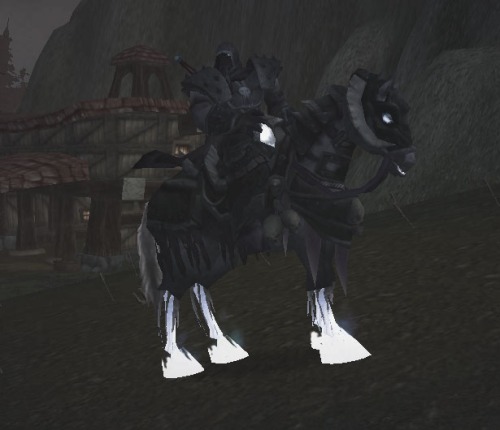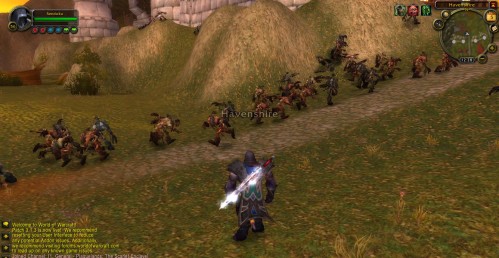(With apologies to J. Robert Oppenheimer and the Bhagavad Gita.)
Sendoku isn’t Vishnu, but as a newly minted Death Knight, subject of the Lich King, he is a harbinger of death, one who uses terror like a madman’s cudgel and fear like a torturer’s scalpel.
Early in his career, he was told that the hunger gnawing at his soul could only be sated by killing. His very first fight set the tone for his existence, as he was told to fight a fellow initiate to the death. The later massacre of scores of soldiers was only a mild escalation in his ultimate task to eradicate all life on Azeroth under the direction of the Lich King.
He is not quite alive, having been reanimated to serve in thrall to the Lich King, nor is he truly dead or undead. He and his brethren are at least somewhat mortal, as some have not survived the Lich King’s war efforts. So he’s understandably confused about his existence, and the suggestion to focus on obedience to the will of the Lich King and the tasks at hand undoubtedly help efforts to ignore exisistential musing.
All his homies agree he really looks good in black, and he’s got a really cool hat.
Even when he will eventually break free of the Lich King’s will, as foretold by this oracle, he will still serve Death, and be a slave to his eternal hunger for killing and destruction. He will turn his blue, glowing eyes to the North, pushing forward with his kin, looking to bring death to the Lich King. …who is already dead. Sort of. And who wields Death for fun and profit.
Death Knights aren’t exactly the sharpest cutlery in the rack, but they may well be the angriest and the angstiest. (Three Panel Soul is highly recommended.)
———-
Short story long, the Death Knights are a mishmash of most emo and necro tropes, complete with big old honkin’ swords that glow like Azerothian lowriders, proving their utter dominance over all things edgy and cool.
Like any other WoW character, they enter the world with a nicely done flyby with a narrative to convey some backstory, and then they look around for questgivers with gold exclamation marks over their heads, positively itching to go kill stuff, but unlike other characters, they kill stuff with Death!!! (Or a big old honkin’ sword, diseases, and maybe a pet Ghoul or three.) Of course, they look better than other newbie characters, as the beneficiaries of years of refinement of Blizzard’s art assets and rendering engine, and they enter the world in full plate armor, at level 55, far more dangerous than a level 1 character.
The lore and art on these Death Knights is very tightly designed, and very well rendered. I make light of it a bit, but that’s because I’m not a fan of the theme of the Death Knights. As an artist in the game industry, I can look at what they are doing with these guys and applaud their art direction, animation and the very strong story and theme that Blizzard has developed, and I give credit where it’s due; the Death Knights are among the best designed characters in the WoW universe, both artistically and mechanically. I personally find the overbearing (even if occasionally lampoonish) focus on Death and Destruction to be distasteful, but I’ll readily concede that even that is extremely well presented. (Is it too punny to give Blizzard brownie points for execution?)
That said, the Death Knights do get bonus points for being honest. Any WoW character embarks in the world as an agent of death, with a long career of slaughter in front of them. Sure, it’s handwaved aside by saying that Druids are “maintaining the balance of nature”, or some other way of villainizing various critters and humanoids (it’s a war, after all, right?), but mechanically, the bulk of the game is about killing stuff. (A point my wife has remarked about on more than one occasion, and really, from the outside, it is pretty silly.) Death Knights know what they are all about, and they embrace it wholeheartedly. That’s not a virtue, especially since they are just out for revenge and killin’, rather than any noble goal, but at least they are honest about what they do.
So what? Do the Death Knights shake off the “monster pinata” complacency that most of us have slipped into? Does it really make a difference when your “kill ten rats” quest turns into “kill 100 soldiers”? Should it? It’s just a game, right?
Hyperbolic German reactions aside (as Longasc points out, German leaders are coming down hard on violent gaming), desensitization is real. The Death Knights are told to kill human characters who will cower and beg for their lives, innocent people who would otherwise be content to see to their village’s need for wood or hay. It’s all very much in theme for the Death Knights, and Blizzard has carefully crafted the experience to give a sense of what a Death Knight’s existence is all about. Does any of that sink in as players just go about, completing quests and killing stuff? Do they think about it, or just go on with the business of prepping a new tank for raids? Do they care even if it does sink in?
Again, it’s extremely well crafted, but I find the subject matter doesn’t sit well with me.
If Blizzard would take this level of work and turn it to a more noble pursuit, I’d be more impressed overall. Of course, they aren’t really trying to impress me, so I doubt they care. That’s just my take on things.
As I’ve noted before, the DK starting quests are very nicely designed, with a clear sense of progression, great spatial location, excellent art direction, and smart teaching mechanics. (The flying eyeball recon quest at the start is a fantastic way to show people around in a low stress manner.) Players don’t get a “this is an optimal DPS rotation” tutorial, but jumping in and playing a DK is a very smooth and forgiving experience. (Ironically so, perhaps, since such would seem to benefit newbies more than vets who have qualified for DKs by having a high level character somewhere.)
The Phasing technology gives a nice sense of progress along a timeline, and really sells the storytelling. It’s still not Hemingway or Shakespeare, but it’s a LOT better than what any other new character will see in WoW.
The Runes and Runic Power system is an interesting mutation of a mating between the Rage and Rogue Combo mechanics, and I found that it nicely promoted optimization of DPS rotations just by how it works, considering the cooldowns of runes and the gradual building of Runic Power. It seems complex at a glance, and it certainly has the potential to be so, but getting up and running with it was a smooth experience.
So, I’ll add my voice to the choir saying that the Death Knight design and starting area is awesome, and that Blizzard really did a great job on them. I won’t sing the praises during the chorus, when the theme is embraced, though. I’m very glad that I had the chance to see a bit of the DK experience first hand, and I have some good screenshots to study… but I can’t honestly say that the experience was a pleasant one, on balance. It was downright uncomfortable, and not something that I’d really want to do again. (Which is not unlike the Arthas novel, actually… well crafted, unappealing characters and theme. It works for some, certainly, just not me.)
The Death Knight experience offers some of the best work that Blizzard has done to date, and if dark magics, necromancy, Death and Destruction don’t bother you, the DK starting zones may well be the best part of the game.
A final note, though… I do wish that Blizzard would turn their eye to crafting this sort of experience for single player games. If this sort of thing, complete with Phasing and a renewed focus on storytelling, is the future of the MMO genre (including SWTOR), I’m really going to be miffed that they didn’t just make a brilliant single player game. More and more, I’m convinced that storytelling just isn’t meant to be a major component of MMO design. Players should be telling their own stories, and all that effort crafting great narrative really should be in single player games, or even films. But that’s another post…
Read Full Post »















